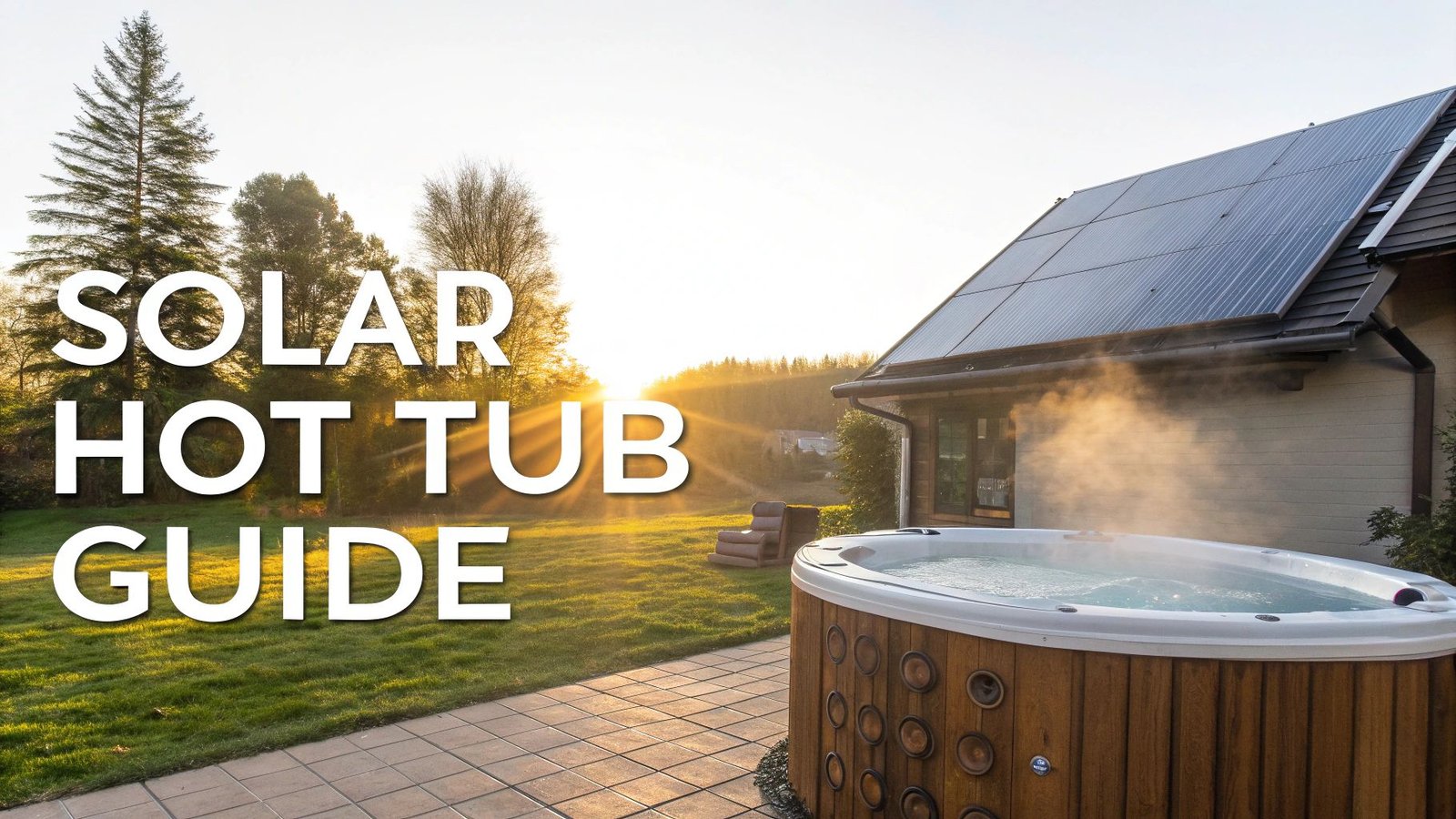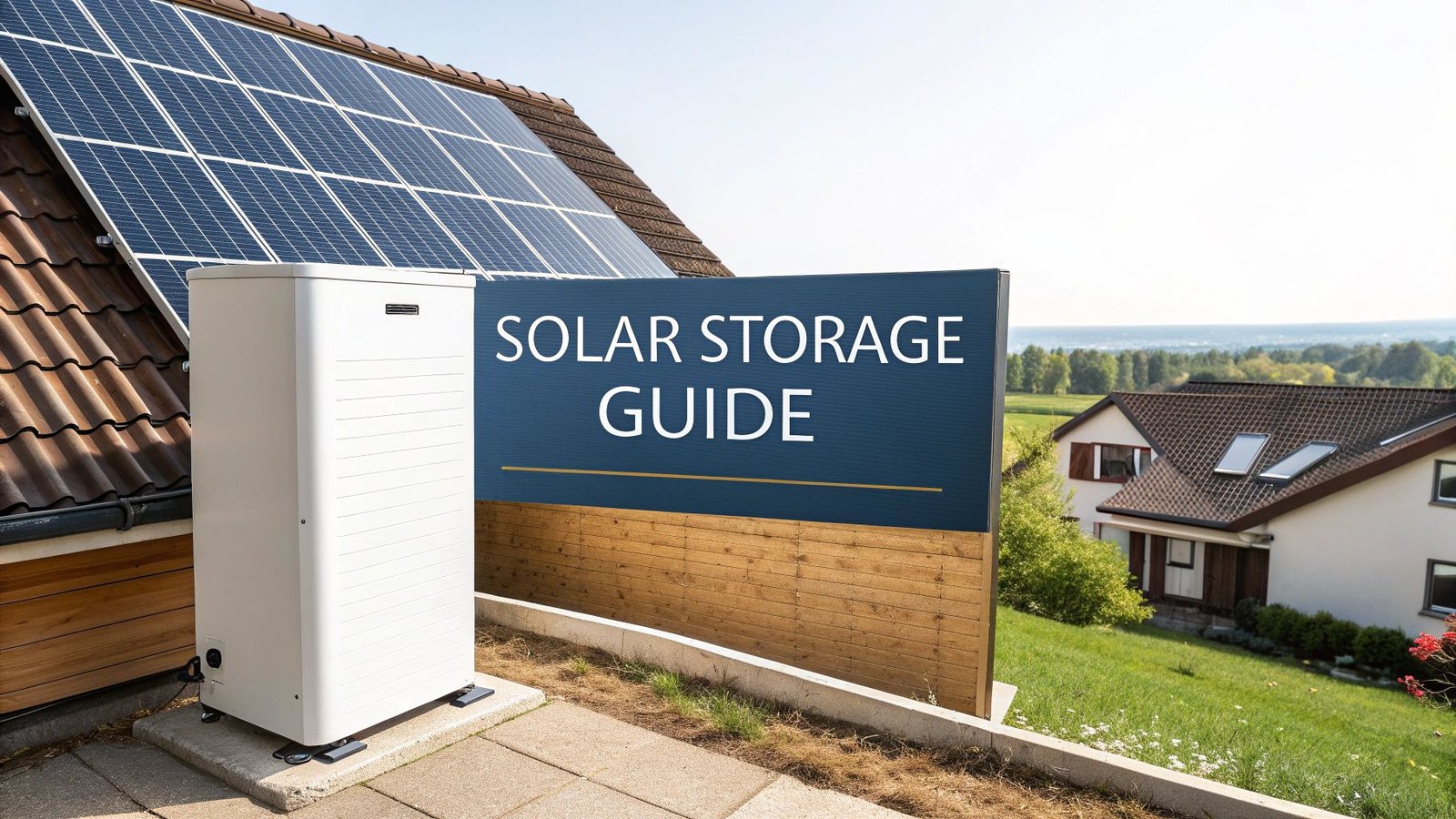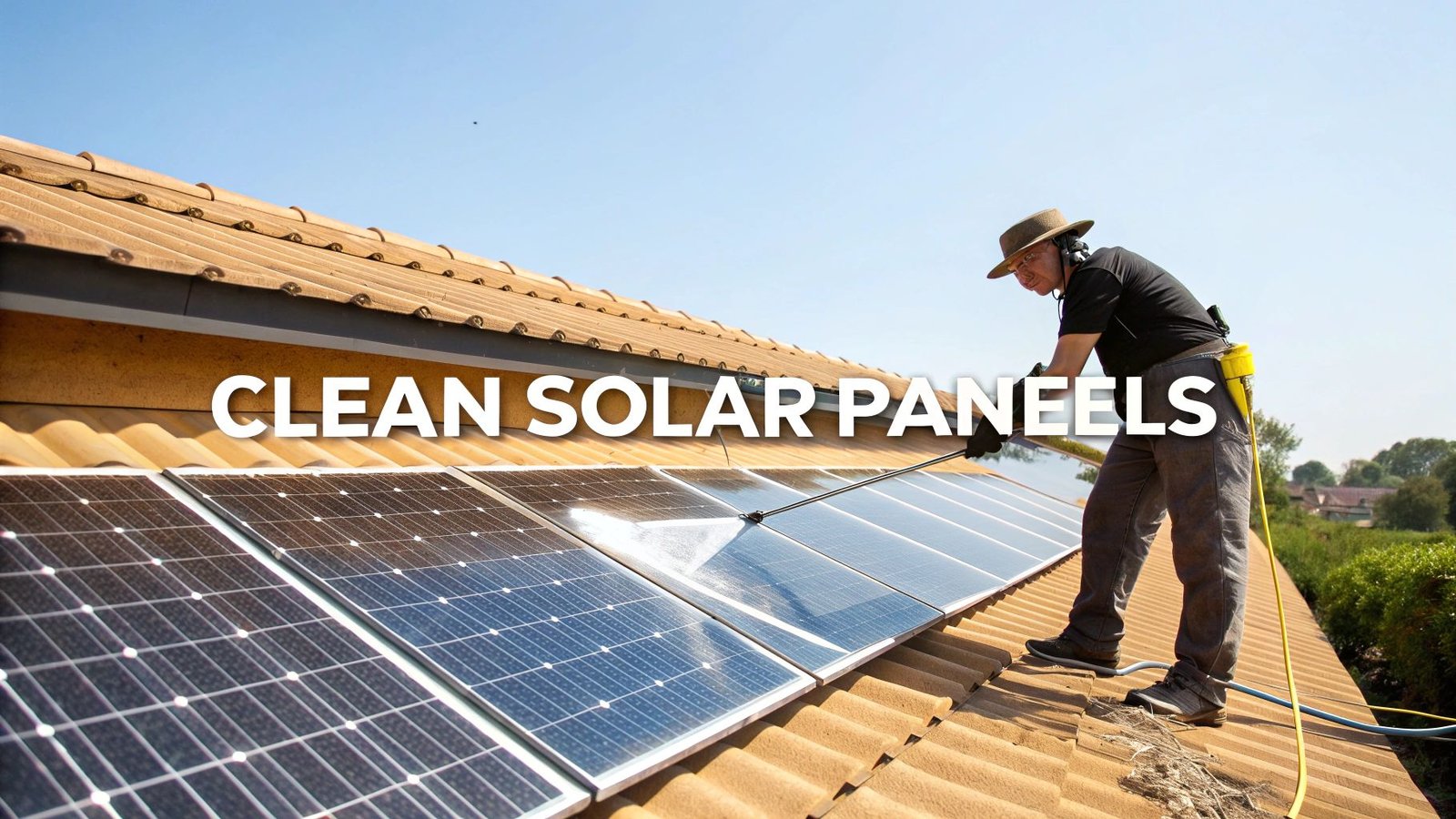Imagine tapping into a free, endless source of energy to heat your hot tub. That's the simple but powerful idea behind a solar hot tub heater. By using the sun's natural warmth, these systems can slash your hot tub's heating expenses by a staggering 50% to 80%. It’s an easy way to make your favorite relaxation spot both sustainable and a lot lighter on your wallet.
Tired of High Hot Tub Energy Bills?
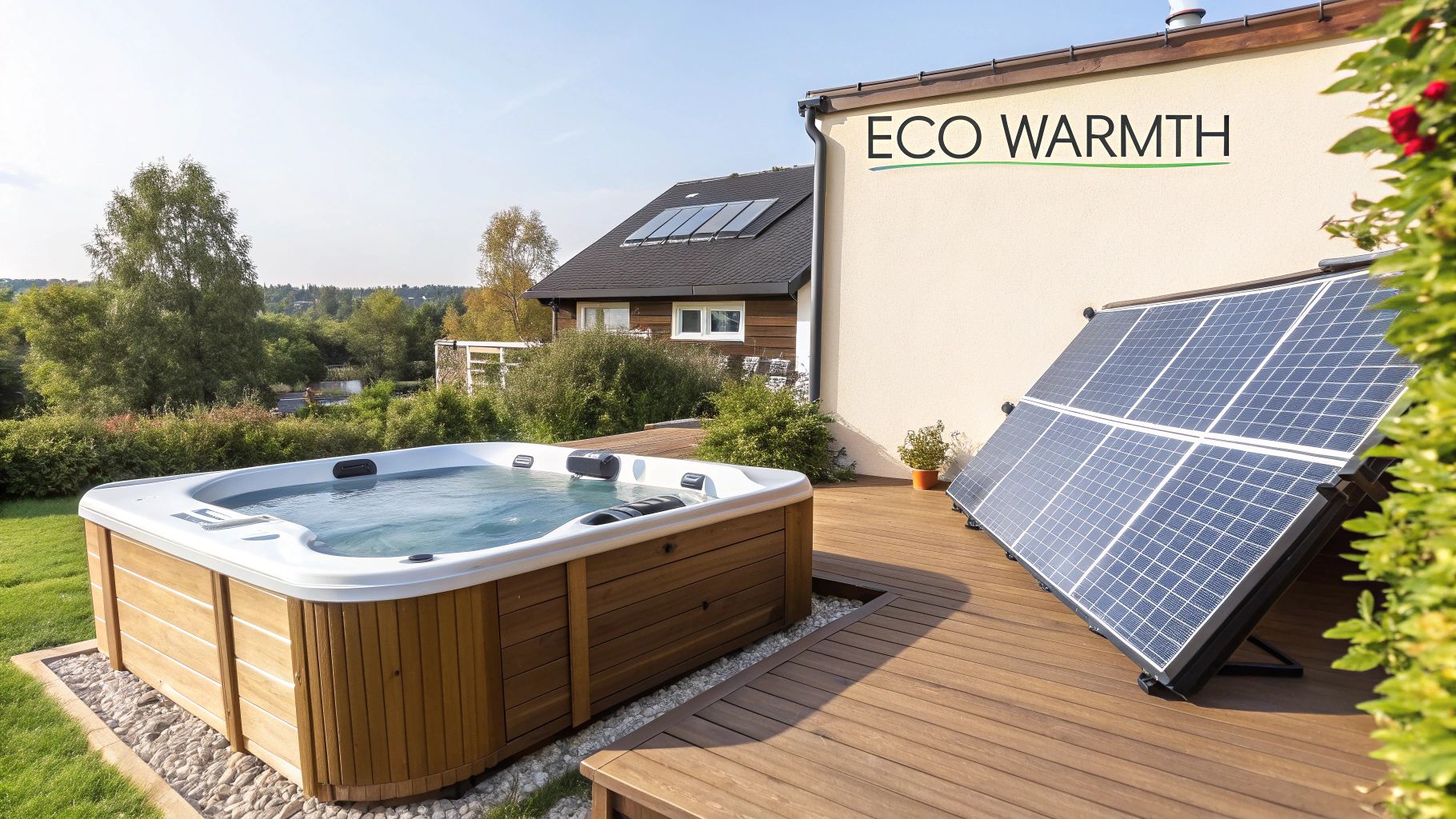
There’s nothing quite like sinking into a warm, bubbling hot tub. But that moment of bliss can feel a little less relaxing when the monthly electricity bill arrives. A traditional hot tub can be a real energy hog, turning a simple pleasure into a constant, nagging expense.
What if you could keep that perfect temperature without the shock of a high utility bill? This guide is all about a smarter way to heat your tub: solar hot tub heaters. We’ll break down how you can use the sun's free energy to drastically cut your running costs and shrink your carbon footprint at the same time.
The Simple Idea Behind Solar Heating
Remember leaving a garden hose out in the sun on a hot day? When you turn it on, the first blast of water is surprisingly warm. A solar hot tub heater works on that very same principle, just in a much more efficient and controlled way. It captures the sun's heat and transfers it directly to your hot tub's water.
This isn't just a clever trick for hot tub owners; it's a key part of a global move toward smarter energy use. In fact, the worldwide market for solar water heaters is expected to jump from USD 3.1 billion in 2025 to USD 5.3 billion by 2035.
This trend shows that more and more people are looking for ways to save money and be more environmentally conscious. This impressive 5.7% annual growth rate is a clear sign that solar heating is here to stay.
What This Guide Will Cover
My goal here is to give you all the practical, no-nonsense information you need to decide if a solar heater is right for you. We’ll go through everything from the basic science to the installation process and what you can expect in long-term savings.
Here’s what you'll learn:
- How solar collectors actually capture heat and get it into your tub.
- The different kinds of solar heating systems on the market.
- How to figure out the right size and type for your climate and hot tub.
- What’s involved with installation and ongoing maintenance (it's easier than you think).
- A realistic look at your potential savings and how quickly the system pays for itself.
While a solar heater tackles your hot tub's energy use directly, it's also worth looking into broader services aimed at energy rate reduction to find even more ways to save around your home. By the time you finish this guide, you’ll see exactly how a solar heater can make your favorite luxury affordable and eco-friendly.
How a Solar Heater Turns Sunshine Into a Steaming Hot Tub
Ever wondered how a few simple panels on your roof can get your hot tub piping hot? It might seem like space-age tech, but the idea behind it is actually pretty simple. A solar hot tub heater is really just a clever system for grabbing the sun's energy, turning it into heat, and moving that heat into your hot tub water.
The whole thing works on a continuous loop. Your hot tub's existing pump sends cooler water up to the solar collectors. As the water snakes its way through these panels, it soaks up the sun's heat before heading back to the tub, gradually raising the temperature with each pass.
This simple diagram shows you exactly how that three-step journey from sunlight to warm water happens.
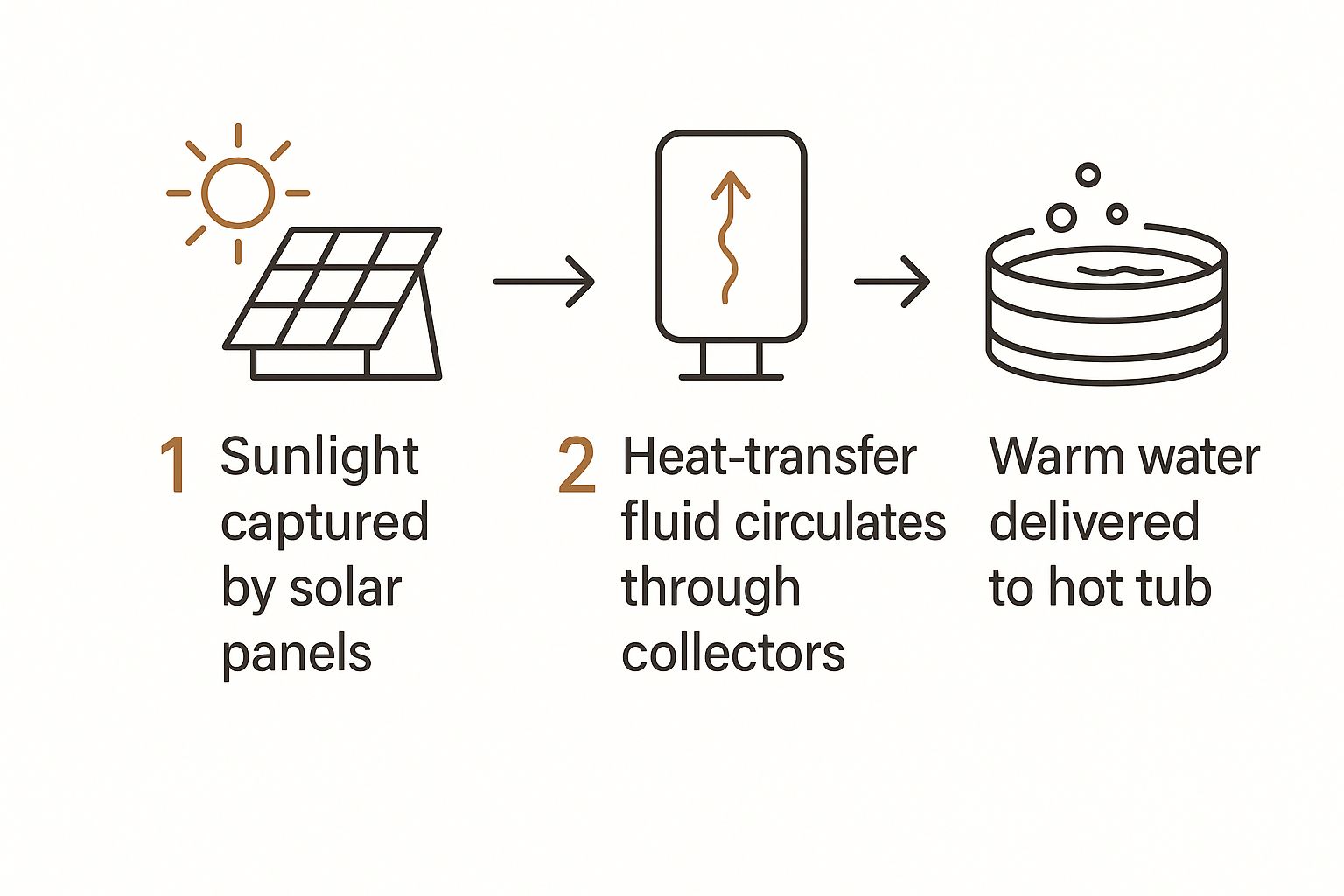
As you can see, it's a clean and direct energy transfer. A small pump just keeps the cycle going, letting nature do the heavy lifting to heat your tub.
The Heart of the System: The Solar Collector
The real magic happens inside the solar collectors—those dark panels that seem to drink in the sunlight. It's important to know these aren't the same as photovoltaic (PV) panels, which create electricity. These are thermal collectors, and their only job is to heat up liquid.
You'll generally come across two main types.
Flat-Plate Collectors
Think about how hot the dashboard of your car gets on a sunny day. A flat-plate collector works on the same principle. It's essentially a shallow, insulated box with a dark absorber plate on the inside and a glass or plastic cover on top.
Small tubes run across the absorber plate, carrying water through the collector. As the sun beats down, the plate gets incredibly hot, and that heat is transferred directly to the water flowing through the tubes. Simple, durable, and relatively inexpensive, they are a fantastic choice for solar hot tub heaters in places with mild to warm weather.
Evacuated Tube Collectors
Now, for a more advanced design, picture a row of high-tech thermos bottles lined up together. That’s the core idea behind an evacuated tube collector. This system is made up of a series of parallel glass tubes. Inside each tube is a smaller absorber tube, and the space between the two is a vacuum.
This vacuum is the secret weapon. It’s an incredible insulator that almost completely stops heat from escaping back into the air. This means the collector can get much hotter and works way more efficiently, even on cold, windy, or cloudy days.
Because they're so good at trapping and holding onto heat, evacuated tube collectors are the go-to option if you want to use your hot tub year-round, especially if you live in a colder climate where a flat-plate collector would struggle in the winter.
Putting It All Together
No matter which type of collector you choose, the whole system works together seamlessly. A temperature sensor keeps an eye on things, comparing the heat in the collectors to the water temperature in the tub.
When the sensor detects that the collectors are significantly hotter, it tells a small, low-power pump to kick on and start moving water. This smart, automated process makes sure you're only collecting heat when it's available and not accidentally cooling your tub down after the sun sets.
This idea of using the sun for thermal energy is much bigger than just backyard hot tubs. It's a key part of a global shift toward sustainable heating. In fact, there were 346 large-scale solar district heating systems in operation around the world by the end of 2024, proving just how powerful and scalable this technology is. Your home system might be smaller, but it’s built on the exact same reliable principles. You can dig into the full report on global solar heating trends to see the bigger picture.
When you break it down, a solar hot tub heater is a beautifully elegant machine. The collectors absorb free energy from the sun, and a pump moves the water. It’s a simple, reliable cycle that transforms pure sunlight into pure, low-cost relaxation.
Choosing the Right Solar Heater for Your Tub
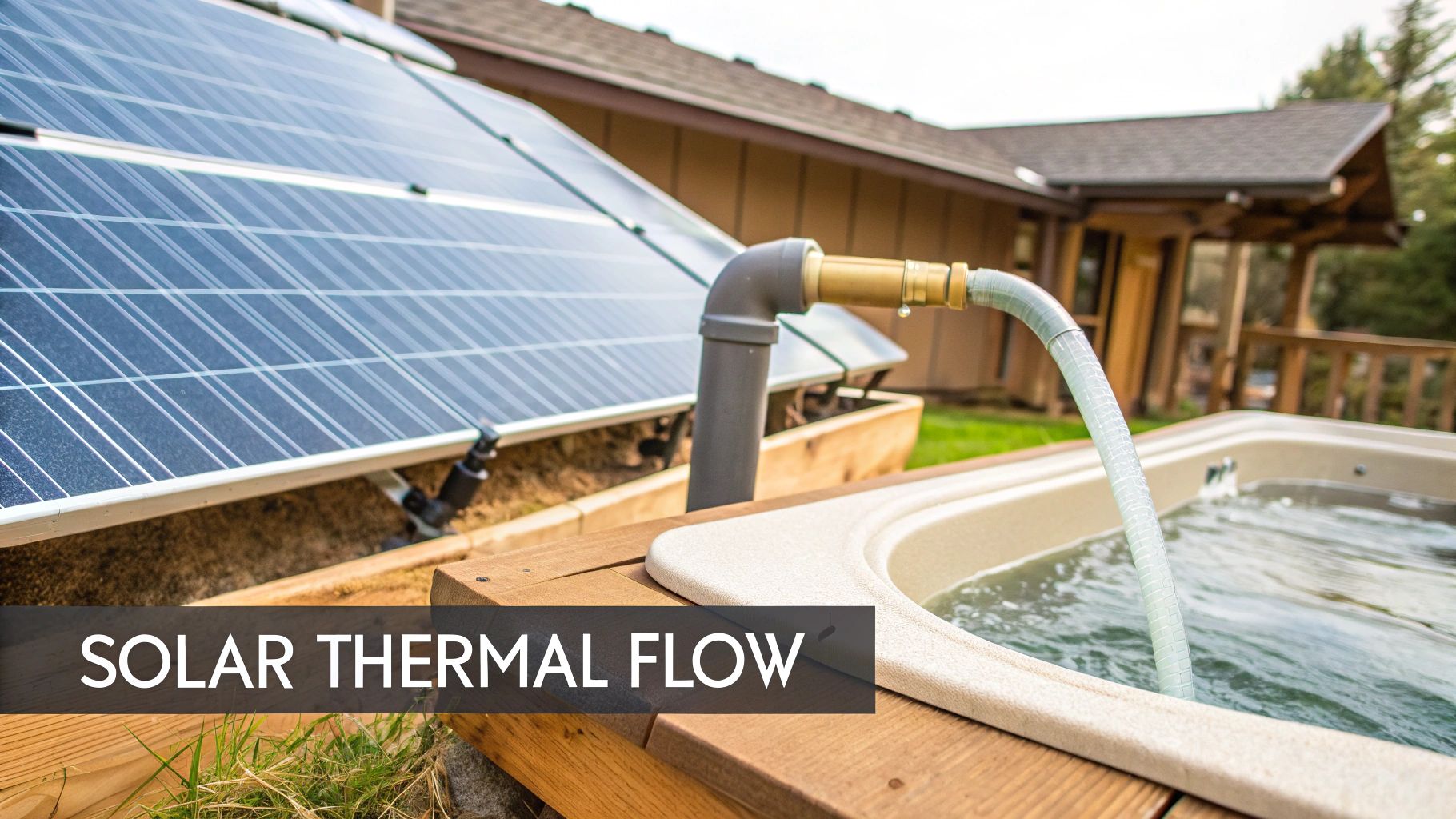
Okay, now that you know how these systems work, it’s time for the fun part: picking the right one. This isn't like buying a new filter at the store; choosing a solar heater is a custom job. The perfect system for your hot tub hinges on a few key things: its size, your local weather, and how much good, direct sunlight your property gets.
Nailing this decision is what separates a great investment from a so-so one. What works wonders for a small two-person tub in sunny Arizona just won't cut it for a big party spa in a cloudier, cooler state. Let's get into the details so you can make the right call.
Sizing Your System for Success
The single biggest mistake I see people make is undersizing their solar collectors. Think of it like trying to cook a huge pot of chili on a tiny camping stove—it’s going to take forever, burn a ton of fuel, and probably won't even get hot enough. A system that’s too small will constantly struggle, forcing your backup electric heater to kick on and completely defeating the purpose.
A solid rule of thumb is to have your solar collector's square footage equal at least 50% of your hot tub's surface area. If you live in a colder climate or just want your tub to heat up faster, I'd strongly recommend aiming for a 75% to 100% ratio.
Let's say your hot tub has a surface area of 40 square feet:
- The absolute minimum: You'll need 20 square feet of solar collectors.
- The smart choice: Bumping that up to 30 or even 40 square feet will give you far better performance.
Properly sizing your system is the most important thing you can do to see real energy savings. Trust me on this: going a little bigger than the bare minimum is an investment that pays for itself quickly with faster heating and less reliance on that power-guzzling backup heater.
Comparing Collector Types
As we covered, the two main players here are flat-plate y evacuated tube collectors, and they perform very differently based on where you live. Your climate really is the deciding factor. A flat-plate setup might be the perfect, cost-effective solution for a vacation home you only use in the summer, but you'll almost certainly need an evacuated tube system for year-round soaks in a place that gets cold winters.
To make this easier, I've put together a table comparing the key features of the most common solar collectors. This should help you figure out the best fit for your climate, budget, and space.
Solar Hot Tub Heater Collector Comparison
| Collector Type | Best Climate | Eficacia | Initial Cost | Space Required | Durability |
|---|---|---|---|---|---|
| Flat-Plate | Warm, sunny climates | Good | Low-Medium | More | Alta |
| Evacuated Tube | All climates, excels in cold/cloudy | Excellent | Medium-High | Less | Moderado |
| Glazed Polymer | Warm, pools & spas | Good (in heat) | Bajo | More | Muy alta |
As you can see, it's all about trade-offs. Flat-plate collectors are tough and budget-friendly, but their performance takes a nosedive when it gets cold. Evacuated tubes, on the other hand, are the champs of cold weather, pulling in heat even on gray winter days. This makes them the clear winner for year-round use in most parts of the country.
While less common for hot tubs, you'll often see rugged glazed polymer collectors in larger setups, and many people explore similar sistemas solares de calefacción de piscinas for bigger bodies of water.
What About Other Heating Options?
It's also worth knowing where solar hot tub heaters fit in with other modern tech. The beauty of solar is its near-zero running cost, but it does need the sun to shine. If you need guaranteed, on-demand heat no matter the weather, other options exist.
For example, advanced heat pumps for pool heating are incredibly efficient and powerful, sometimes coming with handy features like Wi-Fi controls. But they have a higher upfront cost and, unlike solar, they'll always be adding to your electric bill.
Ultimately, the best heater is a balance between your climate, how you use your tub, and your budget. By sizing your system correctly and picking the right collector for your environment, you're setting yourself up for years of cheap, eco-friendly relaxation.
Your Practical Guide to Installation and Setup
Alright, you've picked out the perfect solar heater for your hot tub. Now for the fun part: bringing it to life.
Getting a solar hot tub heater installed might sound intimidating, but it's often more straightforward than people imagine. The job boils down to three main tasks: mounting the solar collectors, plumbing them into your hot tub's existing system, and setting up a small pump to get the water moving.
You've got two basic routes you can go. You can roll up your sleeves and tackle it yourself with a DIY-friendly kit, or you can bring in a professional to make sure everything is perfect from day one.
Deciding Between DIY and Professional Installation
A lot of the solar hot tub heater kits on the market are built specifically for handy homeowners. If you're comfortable with basic plumbing work—think cutting PVC pipes and cementing the fittings—and you've handled some simple wiring before, you can definitely manage a DIY installation. This is a great way to save a good chunk of change on labor costs.
On the other hand, there's a lot to be said for the peace of mind that comes with hiring a pro. An experienced installer instinctively knows how to position everything for maximum sun exposure and will guarantee a leak-free, high-performance system. If you're looking at a tricky roof mount or just aren't feeling confident in your plumbing skills, calling a professional is a smart move.
To get a better feel for what the pros do, you can see a detailed breakdown of the solar panel installation process which shares many of the same core principles.
Key Installation Steps
Whether you do it yourself or hire someone, the core steps don't change. It's all about placing the collectors correctly, connecting the plumbing loop, and wiring up the controller that makes the whole system run automatically.
Here’s a look at how a typical installation plays out:
-
Mounting the Collectors: This is where you can make or break the system's performance. The collectors need to go somewhere with maximum, unobstructed sunlight—usually a roof or a ground-mounted rack. For those of us in the Northern Hemisphere, they should face south and be tilted at an angle that matches your latitude to catch the most rays throughout the year.
-
Running the Plumbing: It's a simple loop. One pipe takes cooler water from your tub's circulation system up to the collectors, and a second pipe brings the freshly heated water back down.
-
Installing the Pump and Controller: A small, low-wattage pump gets installed in the plumbing line. It's controlled by a clever little device called a differential controller, which only kicks the pump on when it senses that the collectors are actually hotter than the water in your tub. No wasted energy.
Consejo profesional: Don't skip the pipe insulation! It's absolutely crucial to properly insulate both the hot and cold water lines running to and from your collectors. You'd be amazed how much heat can be lost from uninsulated pipes, especially over longer runs, and that directly eats into your system's efficiency.
Common Pitfalls to Avoid
A successful installation is all about nailing the details. If you can steer clear of a few common mistakes, you'll ensure your system works like a charm and delivers the energy savings you're after.
Keep an eye out for these potential hangups:
- Poor Collector Placement: Sticking collectors in a shady spot or at a bad angle will cripple their heating ability before you even turn the system on.
- Air Locks in the System: Trapped air is the enemy of circulation. If air gets stuck in the lines or collectors, the water flow can stop completely. The system needs to be filled carefully to push all the air out.
- Incorrect Pump Sizing: A pump that's too powerful doesn't just waste electricity—it can also push the water through the collectors too fast for it to absorb heat properly. It's a delicate balance.
While the components of a solar hot tub heater are unique, many of the plumbing fundamentals are universal. Reading up on some general hot water heater installation tips can provide some great background knowledge for getting the job done safely. Pay attention to these key areas, and you'll be on your way to a smooth installation and a perfectly heated, solar-powered soak.
Calculating Your Costs and Long-Term Savings
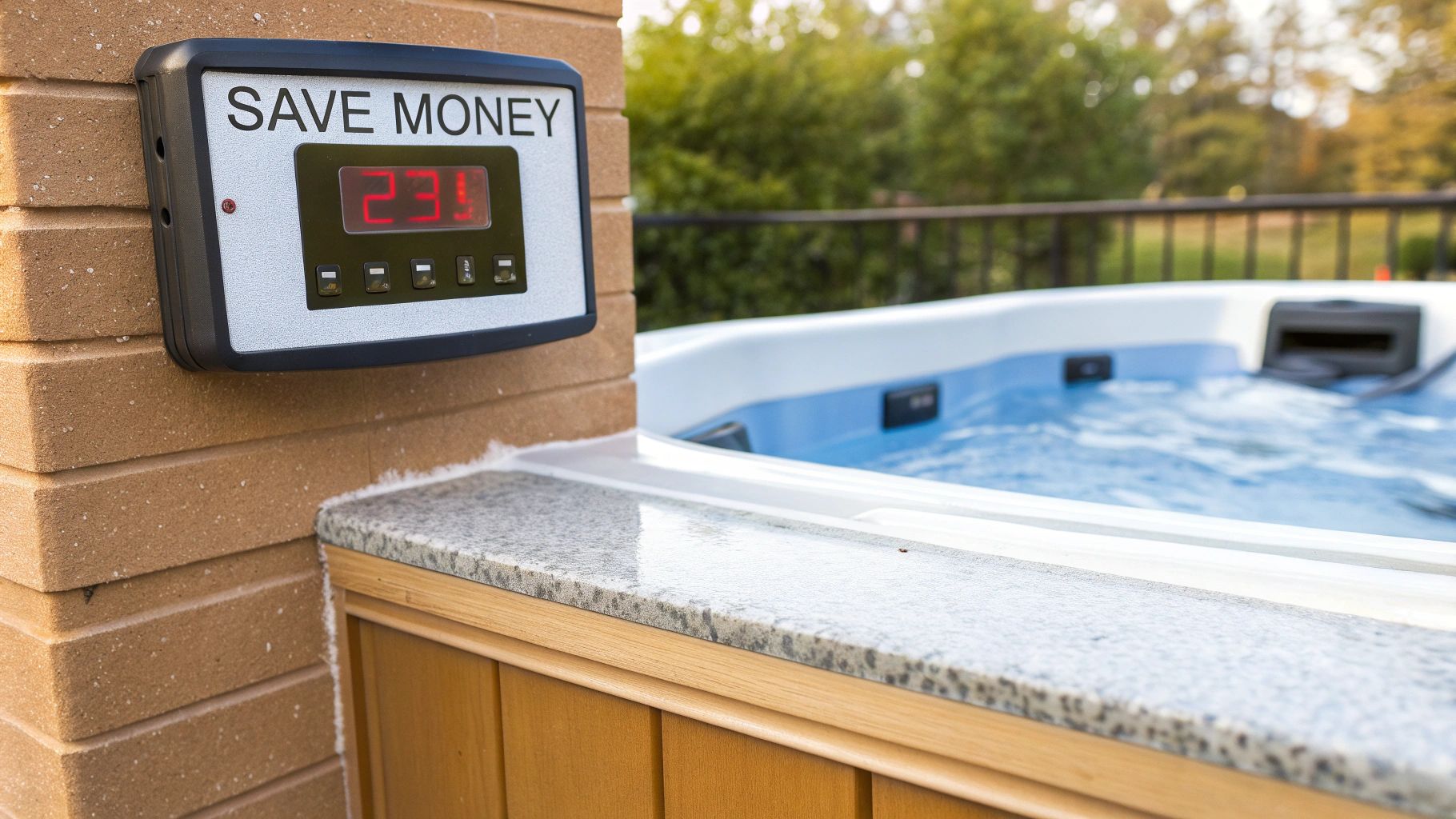
Alright, let's talk numbers. This is where you can really see the power of switching to a solar hot tub heater. While there's an upfront cost, the long-term payoff is where this investment truly shines. We'll walk through the costs and, more importantly, the impressive savings you can look forward to.
The initial price tag is usually the biggest sticking point for most people. This covers the solar collectors, a small circulation pump, a controller, and all the piping to connect everything. If you hire a pro, you'll need to account for their labor, too. But it's best to think of this not as a purchase, but as a long-term investment in cutting your home's energy bills.
Understanding Your Upfront Investment
The total cost can swing quite a bit depending on the size and type of system you choose. A small, simple DIY kit might only set you back a few hundred dollars. On the other hand, a larger, professionally installed system with high-efficiency evacuated tube collectors could run into the thousands.
A few key things will influence that initial price:
- Collector Type: Evacuated tube collectors generally cost more than flat-plate collectors, but they’re the better choice if you live in a colder climate where every bit of sun counts.
- System Size: The more water you need to heat and the less sun you get, the more collector area you'll need—and that increases the cost.
- Installation: Going the DIY route saves you cash on labor, but a professional install ensures everything is positioned perfectly for maximum efficiency, which often means bigger savings down the road.
Choosing solar means you're part of a major trend. The global market for solar water heaters is expected to jump from USD 4.86 billion in 2024 to USD 8.29 billion by 2032. That's a clear signal that more and more people are catching on to these money-saving systems. If you're curious, you can discover more insights about the solar water heater market and see the data for yourself.
Charting Your Return on Investment
Figuring out your return on investment (ROI) is pretty simple. It's the moment when the money you've saved on electricity bills officially covers what you spent on the system. Two things have the biggest impact on how fast this happens: how much you pay for electricity and how much sun your property gets.
The higher your utility rates, the quicker your solar heater pays for itself. If you live somewhere with expensive power and lots of sunshine, your payback period could be just a few years. After that, every bit of heat your system generates is pure savings.
Think of it this way: your solar heater is constantly pre-heating your tub's water for free. Your old electric heater, which used to run for hours, now just has to kick on for short bursts to top off the temperature. That massive reduction in runtime is where the real savings come from.
Tapping into Incentives and Tax Credits
Before you buy, make sure to look into financial incentives that can seriously lower your upfront cost. Many federal, state, and even local governments offer tax credits, rebates, or grants for installing renewable energy systems.
These programs are put in place to help homeowners like you make the switch to greener tech. A federal tax credit, for instance, could shave a huge percentage off the total cost of your equipment and installation. Don't forget to check for local utility rebates, as you can often stack these for even bigger savings, making the decision to go solar even easier on your wallet.
To get a better idea of the impact, let's look at some hypothetical numbers. This chart shows the potential yearly savings when you supplement a traditional electric heater with a solar setup in a moderately sunny area. As you can see, a solar hot tub heater can slash your running costs by over 70%.
And when you combine that with other smart habits, like using one of the best solar pool covers to keep that precious heat from escaping, your savings will add up even faster.
Got Questions? We've Got Answers
Thinking about making the switch to a solar hot tub heater? It's a smart move, but it’s only natural to have a few questions pop up. Let's walk through some of the most common ones we hear from homeowners.
Will a Solar Heater Actually Work on Cloudy Days or in the Winter?
This is easily the number one question people have, and the answer is better than you might think. While a solar heater is obviously going to be a powerhouse on a bright, sunny day, modern systems are surprisingly good at working through less-than-ideal weather.
High-efficiency collectors, especially the evacuated tube types, are designed to capture diffuse sunlight—the kind that gets through cloud cover. So yes, they still generate heat even on an overcast day.
The best way to think about it is this: your solar heater becomes the primary workhorse, handling the bulk of the heating load most of the year. Your hot tub's original electric or gas heater simply becomes a backup, kicking in to top off the temperature during a long stretch of cloudy days or in the dead of winter. It’s a team effort that results in a massive drop in your energy use.
How Much Can I Realistically Expect to Save on My Bills?
This is where things get really exciting. While the exact amount depends on your local climate, system size, and electricity rates, it's very common for a well-sized solar system to slash your hot tub heating costs by 50% to 80% per year.
In sunny areas, some people save even more. The magic is in how it works. The sun does all the heavy lifting for free—taking a large volume of cold water and getting it most of the way to your target temperature.
Your conventional heater's job completely changes. Instead of being the main heat source, it just becomes a "temperature maintainer." It only needs to run for short bursts to add those last few degrees, which is what saves you so much money on your utility bills.
This chart gives you a clear picture of what those savings can look like over a year.
As you can see, the difference isn't small. It's a stark reminder of the financial power of letting the sun do the work.
What Kind of Maintenance Am I Looking At?
One of the best things about solar hot tub heaters is that they are incredibly low-maintenance. They're built to be set-it-and-forget-it systems, so you can spend more time relaxing and less time tinkering.
Honestly, there's not much to it:
- A Quick Rinse: Every few months, just give the collectors a quick spray with a garden hose. This washes off any dust or pollen that might be blocking the sun, keeping them at peak performance.
- An Annual Check-up: Once a year, take a quick look at the system. Make sure the plumbing connections are tight with no signs of leaks, and listen to ensure the small circulation pump is humming along quietly.
And that's pretty much it. When you compare that to the upkeep needed for other types of heaters, the simplicity is a huge win.
Can I Install a Solar Hot Tub Heater Myself?
You bet. Many of the solar hot tub heater kits on the market are designed specifically for the handy homeowner. They typically arrive with detailed instructions and every part you'll need.
If you're comfortable with basic plumbing—like cutting and joining PVC pipe—and can handle some simple, low-voltage wiring for the pump, you can definitely tackle this as a weekend project. A successful DIY install is a fantastic way to save a bundle on labor costs.
However, if your plan involves complicated work on the roof or you're just not 100% confident in your plumbing skills, calling a professional is a smart move. An experienced installer will get the job done right, ensuring your system is perfectly placed and optimized for the best possible performance and your complete peace of mind.
Ready to enjoy a more sustainable hot tub experience while cutting your energy bills? At Energía radiante, we specialize in designing and installing high-quality solar energy solutions that put the sun to work for you. Explore our custom solar systems and start your journey toward energy independence today.

